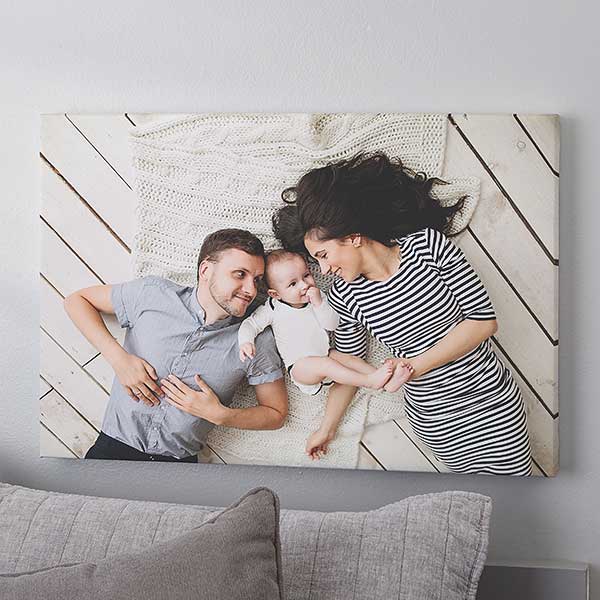
Canvas prints and artwork have become increasingly popular as a great way to decorate your home or office. The stretched canvas prints project an art gallery-like effect as the prints jump out of the wall and create excellent depth perception and viewing pleasure. With so many canvas print options to choose from, however, it can be overwhelming and challenging to know what to order and how best to decorate your walls. But by following the Top 10 Tips for decorating with canvas artwork, you are sure to choose the perfect print that both aesthetically complements your existing furniture while also establishing itself as a central feature and highlight of any room.
1) Complement the Theme or Mood of Your Room:
Understanding a room’s purpose and attributes is important before choosing a canvas print. Is the room private, or is it used to entertain guests? Is the room used for relaxing or performing tasks, or is it just a hallway? Is the room large, narrow or tall? These are clues that will help to determine the type of canvas prints art that will complement the color and scale of a room.
2) Understand the Psychology Between Neutral and Vibrant Colors:
Neutral colors are calming, while vibrant colors bring excitement and action to a room. For example, you might choose brilliant blue colors for a fast-paced office, lively yellow colors for a children’s room or art studio, and neutral beige and mellow green colors for a quiet retreat room or a doctor’s office.
3) Landscape Art Opens Up Small Spaces:
Sunsets, landscapes and canvas art portraying distant horizons are a great way to open up a smaller space visually. The view of a horizon and/or vanishing images act as a sort of “window” that gives the impression of a faraway vista, making a small room feel more comfortable and appear much larger.
4) Print Size Should Depend on Wall Size:
It is best to choose smaller canvas prints for narrow walls and larger canvas prints for big walls and spaces. A large print on a small wall makes the print feel overwhelming and the room seems smaller, while a small canvas print on a large wall makes the room feel disproportionate and empty. One way to test the ideal print size is to use painter’s tape on the wall to indicate where the outside boundaries of a print will be positioned. Another technique is to attach paper or poster board on the wall that is the same size as the print to see how it looks in that position.
5) Canvas Print Selections Should Be Based on Expected Furniture Pairings:
The theme and size of your canvas print should be based on the furniture you plan to hang the print next to or over. When wall art is hung over a piece of furniture, the print size should be no longer than the width of the furniture. Ideally, a general principle is to choose art that is approximately 75% of the width of a piece of furniture. Furthermore, the genre of canvas art to buy depends on the room’s furnishings, such as modern, casual, formal, or traditional furniture and decorations. For instance, flower prints and nature art are great for a casual room, abstract art and grunge prints match perfectly with modern furniture, wine art and cuisine prints are wonderful for a traditional kitchen, and prints of famous landmarks look fantastic in any room!
6) Choosing the Best Canvas Print for You Depends on How You Plan to Use Your Canvas Art:
Some of the most popular canvas print types are a standard wrap, gallery wrap, black sides, and triptychs. While each canvas type is excellent and looks amazing on any wall, the choice of which one is best for you depends on various factors.
• Standard Wrap: The printed image wraps around the canvas print’s side stretcher bars, which are typically 0.75 inches deep, resulting in the printed image continuing on the sides of the print product. The result is that the printed image is viewable from all angles. The Standard Wrap option is great for most prints, especially where the main focus of an image does not extend close to borders so to ensure that important components of the artwork do not get stretched onto the sides.
• Gallery Wrap: The printed art image wraps around the print’s side stretcher bars, similar to the standard wrap. However, the gallery wrap canvas stretcher bars are thicker (usually 1.50 inches), resulting in an art gallery-type effect with a greater depth perspective. This option is great for most canvas prints, except where critical parts of the image run close to the borders because these important components could get stretched off on the top, bottom, or sides of the print. With thicker stretcher bars, more of the image is stretched around to the sides than the standard wrap.
• Standard Black Sides: The overall size and depth are the same as the standard wrap, however, the image is not stretched on the sides. Instead, the entire printed portion of the image is on the front, while the sides are painted black. This option is great for framing the canvas print yourself (because the width of standard black sides is usually the standard size for frames) or if you prefer the sleek look of black on the sides.
• Gallery Black Sides: The overall print size and depth are the same as the gallery wrap. However, the image is not stretched around the sides, but rather the complete printed portion is visible on the front and the sides are painted black. This option is perfect for when the image would lose key aspects if wrapped, or when the black sides augment the canvas print, such as for black and white prints.
• Triptych: One large image is split into thirds and printed on three separate prints that are hung next to each other. This creates an outstanding effect by extending the length of a wall or hallway and visually appearing as if you are looking out a window at the image. Triptych is perfect for large rooms or hallways where you want to separate and extend a single image (such as a cityscape) to occupy more wall space but still maintain a sense of continuity among prints.
7) Mantles and Shelves are Great Ways to Display Art:
Canvas prints do not need to be hung above furniture or stand alone on a wall. Mantles and art shelves are also a great way to present art. Canvas prints can be set on the mantle or shelf-top and leaned against the wall (such as above a fireplace), set onto a shelf with other decorative objects, or hung on the wall over the shelf or mantle.
8) Arrangements Add a New Dimension to Decorating:
A common arrangement method is to align several prints next to each other to fill up space across a wall. Typically, these prints share a similar motif or design pattern for a consistent theme, but unlike triptychs, each print is unique. For example, one might line up three pictures of animals or five prints of flowers, or emphasize a similar color scheme among prints.
• Vertical Arrangements: Hanging canvas prints in a vertical line adds to a sense of height in a room
• Horizontal Arrangements: Hanging wall art in a horizontal line can give the illusion of width in a narrow room and tends to be calming
• Diagonal Arrangements: Diagonal arrangements, such as prints hanging diagonally down a stairway, add excitement to a composition
9) Decorate Using an Odd Number of Prints:
Choosing an odd number of prints helps to create a symmetrically appealing design with both central and peripheral focal points, but it is important that the artwork is balanced to fit the size of the wall and the room. In many instances, one large canvas print is big enough to enliven a room and cover a wall. However, if a single print is not large enough for a big wall, or if you enjoy the look of multiple prints on a wall, then choose 3 or 5 medium or small-sized prints to hang.
10) Viewing Pleasure is Maximized When Art is Hanging at an Optimal Height:
Canvas prints should be hung where the central point of the image or grouping is at eye level for the average person, which is approximately 60-65 inches from the floor. However, there are other factors to consider when choosing height.
• Purpose of Room: If people will mainly be standing in a room, then hang your print around 65 inches from the floor. However, if people will mainly be sitting down in the room, such as an office or dining room, then hang the print a bit lower so that they can be enjoyed at a lower viewing angle.
• Print Orientation and Size: If you hang a tall vertical canvas print, position the print so that the top 1/3 area of the picture is at eye-level. Additionally, a large canvas print or grouping of small prints that are hung over a sofa should be placed so that the bottom of the print is approximately 12 inches above the top of the sofa.






